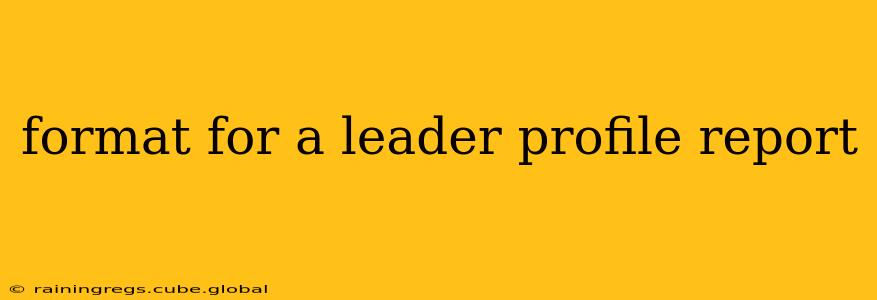The Ultimate Format for a Leader Profile Report: Crafting a Compelling Narrative
A leader profile report goes beyond a simple resume; it paints a vivid picture of a leader's capabilities, experiences, and potential. This format emphasizes storytelling, showcasing impact rather than just listing accomplishments. It’s designed to be both informative and engaging, suitable for internal assessments, succession planning, or external presentations.
I. Executive Summary (One Page Maximum)
- Headline: A concise and compelling statement summarizing the leader's key strengths and potential. Example: "Sarah Chen: A Visionary Leader Driving Innovation in Sustainable Energy."
- Key Strengths: Highlight 3-5 core competencies demonstrated consistently throughout their career. Use strong action verbs. (e.g., Successfully launched, Strategically partnered, Effectively mentored).
- Key Accomplishments: Briefly showcase 2-3 significant achievements with quantifiable results whenever possible.
- Leadership Style: Provide a concise overview of their leadership approach (e.g., transformational, collaborative, servant leadership).
- Potential and Next Steps: Briefly outline their future potential and recommended development areas.
II. Leadership Journey (Chronological Order)
This section tells the story of the leader's career progression, highlighting key roles and responsibilities. For each role:
- Company & Title: Clearly state the organization and job title.
- Tenure: Specify the start and end dates of employment.
- Key Responsibilities: Describe their core responsibilities, focusing on those most relevant to their leadership capabilities.
- Significant Accomplishments & Impact: This is the heart of the section. Use the STAR method (Situation, Task, Action, Result) to illustrate specific achievements. Quantify results whenever possible (e.g., increased sales by 15%, reduced costs by 10%, improved employee satisfaction by 20%). Focus on demonstrating leadership skills such as problem-solving, decision-making, strategic thinking, team building, and communication.
- Leadership Lessons Learned: Briefly describe any key lessons learned or challenges overcome during this role, demonstrating self-awareness and growth.
III. Leadership Competencies & Skills
This section provides a deeper dive into the leader's specific skills and competencies. Organize this by competency category (examples below):
- Strategic Thinking & Vision: Provide examples of their ability to develop and articulate a clear vision, anticipate future trends, and make strategic decisions.
- Decision-Making & Problem-Solving: Showcase instances where they effectively analyzed complex situations, identified solutions, and made timely decisions.
- Team Leadership & Collaboration: Illustrate their ability to build high-performing teams, foster collaboration, and mentor team members.
- Communication & Influence: Provide examples of effective communication styles, ability to influence others, and build strong relationships.
- Change Management: Showcase their experience in leading organizational change initiatives, managing transitions, and overcoming resistance.
- Innovation & Creativity: Highlight instances where they demonstrated innovative thinking, developed new ideas, and implemented creative solutions.
IV. 360-Degree Feedback (Optional, but Highly Recommended)
If available, include anonymized feedback from peers, subordinates, and superiors. This adds valuable context and provides a more holistic view of the leader's strengths and areas for development. Present this feedback thematically, focusing on recurring patterns and insights.
V. Development Plan (Future Focus)
Outline specific recommendations for the leader's future development. This might include:
- Key Development Goals: Identify 2-3 specific areas for improvement.
- Actionable Steps: Suggest concrete steps to achieve those goals (e.g., mentorship program, specific training courses, participation in leadership workshops).
- Timeline: Set realistic timelines for achieving these goals.
VI. Conclusion
Summarize the key findings of the report, reiterating the leader's strengths, potential, and areas for development. Offer a final assessment of their overall leadership capabilities.
VII. Appendix (Optional)
This section could include supporting documents such as performance reviews, awards, or other relevant materials.
This comprehensive format provides a robust and well-structured framework for creating a compelling leader profile report. Remember to tailor the content to the specific audience and purpose of the report. Using consistent formatting, clear language, and compelling storytelling will ensure its impact.
